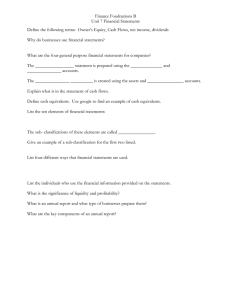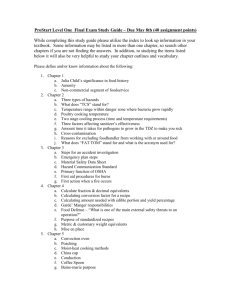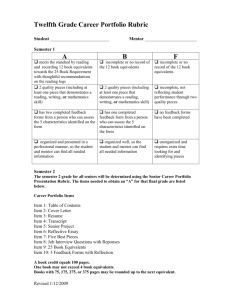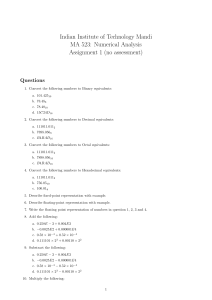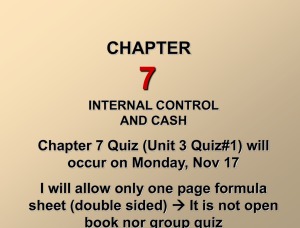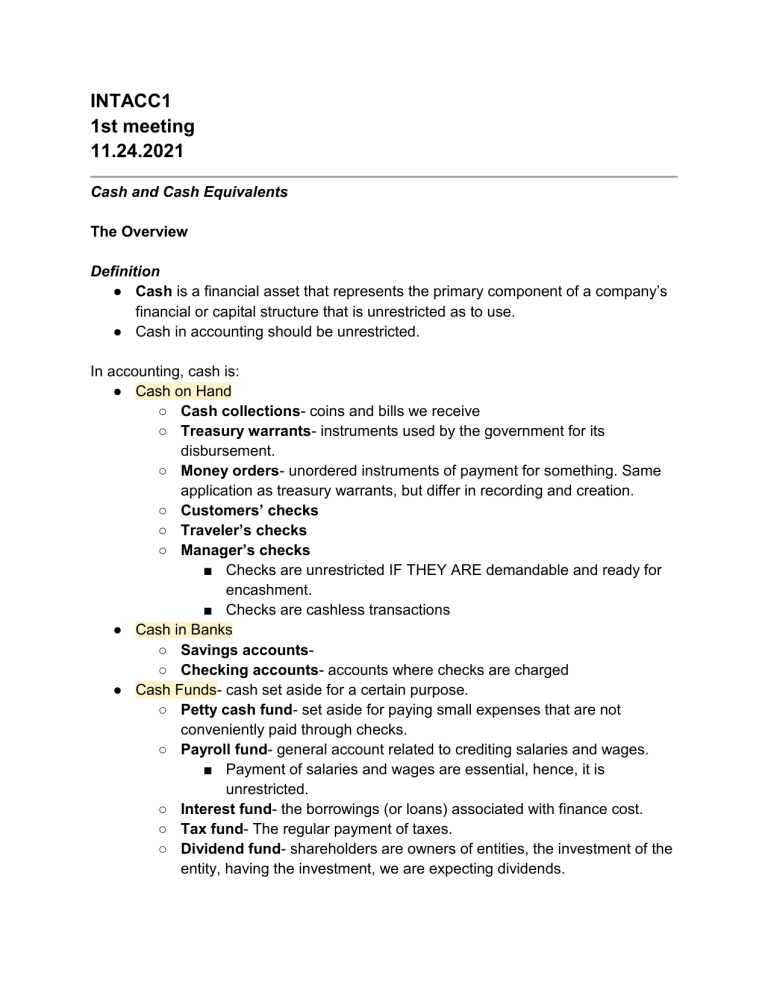
INTACC1 1st meeting 11.24.2021 Cash and Cash Equivalents The Overview Definition ● Cash is a financial asset that represents the primary component of a company’s financial or capital structure that is unrestricted as to use. ● Cash in accounting should be unrestricted. In accounting, cash is: ● Cash on Hand ○ Cash collections- coins and bills we receive ○ Treasury warrants- instruments used by the government for its disbursement. ○ Money orders- unordered instruments of payment for something. Same application as treasury warrants, but differ in recording and creation. ○ Customers’ checks ○ Traveler’s checks ○ Manager’s checks ■ Checks are unrestricted IF THEY ARE demandable and ready for encashment. ■ Checks are cashless transactions ● Cash in Banks ○ Savings accounts○ Checking accounts- accounts where checks are charged ● Cash Funds- cash set aside for a certain purpose. ○ Petty cash fund- set aside for paying small expenses that are not conveniently paid through checks. ○ Payroll fund- general account related to crediting salaries and wages. ■ Payment of salaries and wages are essential, hence, it is unrestricted. ○ Interest fund- the borrowings (or loans) associated with finance cost. ○ Tax fund- The regular payment of taxes. ○ Dividend fund- shareholders are owners of entities, the investment of the entity, having the investment, we are expecting dividends. ○ Business travel fund- They must be for business purposes, like annual meetings for owners, team buildings, seminars. Cash Equivalents - Are short-term, highly liquid investments that are readily convertible to known amounts of cash which have short maturity of, say, three months or less from the date of acquisition. (PAS 7, paragraph 6-7) - Are not equal to the definition of cash but are equivalent to cash because they are readily convertible. In accounting; cash equivalents: PH Interpretation Committee 1. Items not as mere “investment and other purpose” but held for meeting “short term cash commitments” 2. Items that are proven with strong evidence and in substance, as cash equivalents. (kahit hindi ma meet ung short maturity, but in substance, is a cash equivalent, it is considered a cash equivalent, still.) a. Current- one year or less, if assets are realizable or liabilities are due. But if the operating cycle is longer than 1 year, the item, though realizable in one year, is still considered as current. Examples ● Treasury bills ● Certificate of time deposit/ Certificate of deposit/Time Deposit; in a form of Bank Deposit ○ Time deposit is not cash in the bank because it has a maturity value. Cash in bank however has no maturity. ● Commercial papers ● Short-term government bonds ○ Asset to the one who purchased the bond ● Shares with “redemption value” ○ The usual share with redemption value is the preference shares. ○ If the preference shares are invested, there is a redeemable value. Notes to be considered: 1. Cash equivalents are not yet cash as they do not satisfy the criteria of being “unrestricted” 2. Cash equivalents are “nearly cash” as they satisfy the criteria of “readily convertible to cash” 3. Equity and other investments which do not have maturity date are not cash equivalents, unless proven and in substance are cash equivalents. Recognition Criteria 1. No accounting or reporting standard is specific for the accounting for cash and cash equivalents 2. PAS 7 provides for definition and available recognition criteria but not the entire accounting. In accounting, cash; Generally 1. Unrestricted as to use; or 2. Readily available; or 3. Immediately accessible PH Interpretations Committee ● Items of cash that are “restricted” but the restriction does not prevent such item from being used for normal trading purpose, can still qualify as cash accounting, cash equivalent; Generally 4. Short-term 5. Highly liquid investment 6. With 3 month maturity from acquisition date PH Interpretations Committee ● Other items of deposit or investment that meet the following concepts can qualify as cash equivalent: ○ “Insignificant risk of changes in value”; ■ The market rate or factors does not provide the fluctuation of the value of cash equivalents. ○ “Short-term cash commitment” ■ As long as the cash equivalent is for short term cash commitment, then it is recognized as cash equivalents. Measurement - Items of cash and cash equivalents are measured at the amount or value of assets that are (immediately) cash or can be converted into cash immediately. In accounting, cash; Generally Foreign Deposit At face value, which is the actual legal value of cash. At current exchange rate when converted in PH peso (piso) At estimated realizable value or the amount recoverable. Example: $1= P50.62 hose cash deposits in closed banks, we can’t account it already as cashT (but if we are experiencing inflation or we are in a hyper-inflationary economy, the value of ph peso may not be at face value anymore.) In closed Banks Example: PDIC Law Example: PH peso In accounting, cash equivalents; In accordance with PFRS 9 1. Items of “investments” held for meeting “short-term cash commitments” and other cash equivalents are measured, in general, at amortized cost- which approximates or estimates the fair value of the cash equivalent. 2. Cash equivalents are, in fact, financial assets with maturity date with emphasis on “insignificant risk or changes in value: within the maturity period. FS Presentation: (Cash and Cash Equivalents) Statement of Financial Position (balance sheet) Under the current assets section as one line-item account showing the combined total of cash and cash equivalent items Notes to Financial Statements The items that compose the one line-item account CASH AND CASH EQUIVALENTS including the accounting and management policies are required disclosures.
